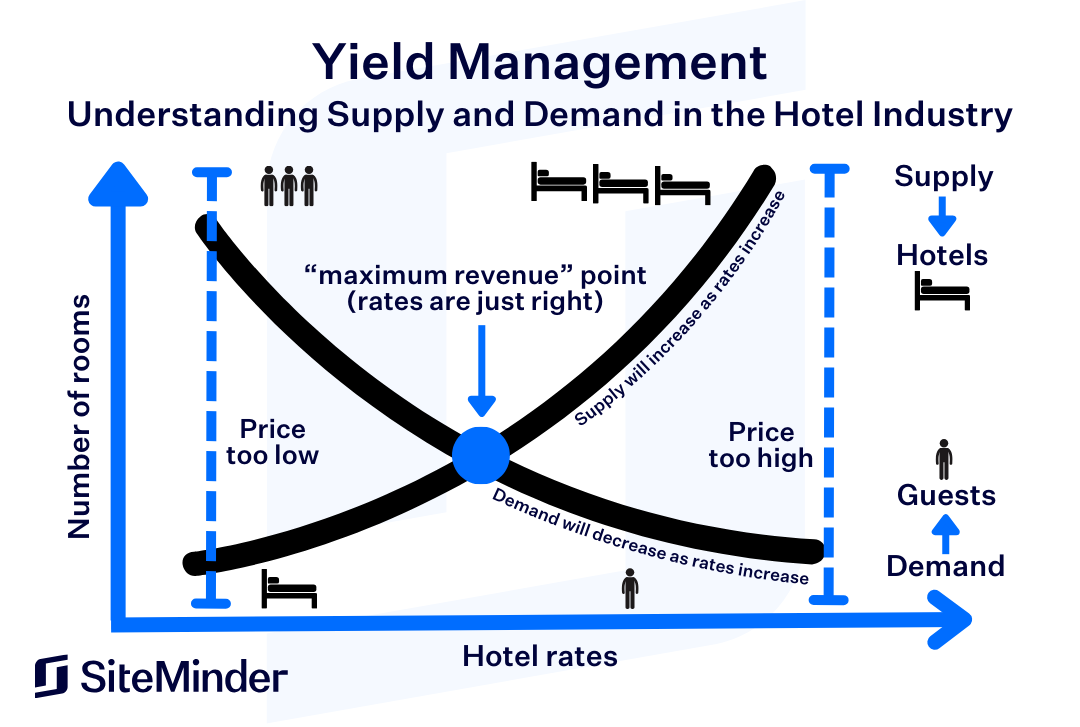What is Yield Management?
Yield management is a pricing and revenue management strategy that is used to maximise business performance. It involves adjusting prices based on predicted demand and other external factors to maximise revenue or yield. The main goal is to sell the right product to the right customer at the right time for the right price.
For hotels, the ultimate aim of yield management is to increase revenue by leveraging the balance between supply (available rooms) and demand (guest bookings). By understanding and anticipating guest behaviour and market dynamics, hotels can optimise their pricing strategies to boost their bottom line.
In essence, the concept is based on understanding, anticipating and influencing your guests’ behaviour in order to maximise revenue or profits for your hotel. Think of it as the art behind the science of room supply and demand.
Good examples of yield management can also be found in grocery stores, where the most profitable items are placed at eye level. A similar principle can apply to distribution. A lot of ‘products’ are based on the willingness of the customer to pay. This will vary depending on when someone is buying – hotels will often provide discounts for early bookers, offer lower rates on Sundays, enforce minimum stays etc.
Table of contents
History and development of yield management
Yield management, which originated in the airline industry, marked a revolutionary shift in how businesses approached supply and demand. Airlines, through this strategy, could charge fluctuating prices for the exact same flight seat based on factors like purchase timing or seat preferences. Observing the success of this model, the hotel industry didn’t lag behind and started integrating these principles by the late 1980s and early 1990s. This integration saw the rise of specialised roles, with dedicated yield managers at the helm, steering the industry’s pricing strategies. Over time, these roles matured and transformed, giving birth to the modern-day revenue or reservations managers. In the context of smaller establishments, such as boutique hotels or bed and breakfasts, it’s often the general manager who dons the hat of a revenue manager, juggling multiple responsibilities.
However, the essence of yield management extends far beyond just filling up rooms or seats. It’s about extracting the maximum possible value from every available resource. Today’s revenue managers, equipped with advanced tools and analytics, are delving into a more granular level of data. They’re not just satisfied with traditional metrics like ADR or RevPAR. Instead, they’re exploring sophisticated indicators like GOPPAR to gain a holistic view of their operations.
But the evolution doesn’t stop there. The modern approach to revenue management encapsulates the entire guest journey. It’s not just about how much a guest pays for a room, but also about how their entire stay can be enhanced and monetised. This includes offering tailored packages, suggesting room upgrades, promoting in-house dining experiences, and even curating special entertainment events. Every touchpoint, from the moment a guest checks in to the time they check out, is seen as an opportunity to enhance their experience and, in turn, boost revenue.
This holistic approach signifies the industry’s transition from a narrow focus on yield management to a broader, more encompassing strategy of revenue management. It’s a testament to how industries adapt, grow, and refine their strategies in response to changing market dynamics and customer expectations.
More revenue, less work
What if you could optimise your hotel's yield while also reducing your workload? Our smart hotel platform helps you do exactly that.
Learn more
Yield management vs revenue management
The goal of yield management is not merely to increase room rates or occupancy; rather, it’s to maximise your hotel’s revenue by forecasting your room supply and demand across a variety of key factors.
Yield management shares many similarities with the concept of revenue management, but has actually existed for longer. Nevertheless, it is important to note that yield management has a more narrow focus and is concerned only with the selling price and the volume of sales, so that the best possible revenue yield can be achieved. In some respects, early yield management could be seen as tactical, rather than strategic and had a narrower focus – for example selling a plane seat, event ticket, or a hotel room, but not considering ‘secondary’ spend in other areas (food, drink, merchandising, additional baggage allowance), or the costs associated with the sale.
Revenue management is more sophisticated and measures a lot more variables, from metrics to segments, to different departments of the hotel. Revenue management is the focal point for hotels in today’s climate.
To help explain this further, please watch this video explaining yield management’s evolution to revenue management:
There’s also a distinct difference between reservations management and revenue management. Reservations management can be defined as a service role which includes tasks such as assigning room categories, dealing with VIP guests, customer interaction, converting calls to bookings, updating availability, and managing upgrades.
On the other hand revenue management is an analytical, strategic role. There is no customer interaction, rather a day will be spent in spreadsheets looking at revenue and profits, channels and distribution, segments etc. In larger hotels (500+ rooms), there could be a Director of Revenue and a Director of eCommerce, plus a team of people in the reservations department.
Why is yield management important in the hotel industry?
Yield management is crucial in the hotel industry for several compelling reasons:
- Maximising Revenue: At its core, yield management is about selling the right room to the right guest at the right time for the right price. By adjusting room rates based on demand, seasonality, and other external factors, hotels can optimise their pricing to maximise revenue.
- Optimising Occupancy: Hotels have a fixed number of rooms, making it essential to ensure high occupancy rates. Yield management helps hotels strike a balance between full occupancy at lower rates and lower occupancy at higher rates, ensuring a consistent revenue stream.
- Competitive Advantage: In a saturated market, hotels that employ yield management effectively can gain a competitive edge. By understanding market dynamics and guest behaviour, they can offer attractive rates and packages that appeal to potential customers.
- Informed Decision-Making: Yield management relies heavily on data analytics. This data-driven approach allows hoteliers to make informed decisions about pricing, promotions, and packages based on historical data, market trends, and forecasts.
- Resource Allocation: By predicting demand, hotels can allocate resources more efficiently. For instance, if a hotel expects high occupancy due to an upcoming event in the city, they can ensure adequate staffing and inventory to cater to the influx of guests.
- Enhancing Guest Experience: By offering dynamic pricing and packages, hotels can attract a diverse range of guests. This diversity can lead to a richer guest experience, as guests feel they’re getting value for their money.
- Adapting to Market Changes: The hotel industry is influenced by various external factors, from economic downturns to global events. Yield management allows hotels to be agile and adapt their strategies quickly in response to changing market conditions.
In essence, yield management is a strategic tool that empowers hoteliers to navigate the complexities of supply and demand, ensuring profitability and sustainability in a competitive landscape.

What is the definition of yield management for hotels?
In theory, yield management allows hotels to maximise the amount of money they can make from a finite number of rooms that need to be sold on a deadline, i.e in one day, week, or month.
It’s important to consider that every hotel has a fixed number of rooms in their inventory and different customer segments such as leisure and business travellers, who are willing to pay different prices.This means that hoteliers need to focus on the strategic control of their inventory in order to sell their rooms to the right customer, at the right time and for the right price. The use of yield management should factor in the costs of channels – from GDSs, OTAs, wholesalers, meta search sites and property websites to direct calls – and therefore how to better yield your inventory by channel, customer and more.
What are the elements of hotel yield management?
Hotel yield management encompasses a range of elements that work in tandem to optimise room rates and occupancy for maximum revenue. Here are the key elements of hotel yield management:
- Demand Forecasting: Predicting the number of guests or bookings for a given period based on historical data, market trends, local events, and other influencing factors.
- Dynamic Pricing: Adjusting room rates in real-time based on current demand, seasonality, competitor pricing, and other external factors.
- Inventory Control: Managing the number of rooms available for different rates, packages, or booking channels. This can involve overbooking strategies to account for last-minute cancellations or no-shows.
- Segmentation: Categorising guests based on various criteria like booking behaviour, purpose of visit (business or leisure), or price sensitivity. This helps in tailoring specific offers or rates to different guest segments.
- Distribution Management: Overseeing the various channels through which rooms are sold, such as direct bookings, online travel agencies (OTAs), or traditional travel agents. Each channel has its own cost and reach, affecting the overall revenue.
- Performance Analysis: Regularly reviewing and analysing the outcomes of implemented strategies. This involves tracking key performance indicators (KPIs) like Average Daily Rate (ADR), Revenue Per Available Room (RevPAR), and Gross Operating Profit Per Available Room (GOPPAR).
- Competitor Analysis: Monitoring the pricing strategies and occupancy rates of competitors to understand market positioning and make informed pricing decisions.
- Overbooking Strategy: Intentionally accepting more reservations than available rooms, anticipating that a certain percentage of guests will cancel or not show up. This strategy aims to ensure maximum occupancy.
- Group Management: Handling bookings for large groups differently, as they occupy a significant portion of the inventory and often come with negotiated rates.
- Restrictions Management: Implementing restrictions like minimum stay requirements during peak periods or special events to optimise room revenue.
- Technology Integration: Utilising specialised software and tools that automate many of the yield management processes, providing real-time data and analytics to assist in decision-making.
Optimise your pricing and maximise room revenue
SiteMinder connects with leading revenue management systems to automatically update your optimised rates across all distribution channels in real-time, maximizing the yield of every room through intelligent pricing.
Learn More
Yield management pricing examples
A simple example might be a hotel that is located next to a stadium. On the days around the concert or sporting event, the hotel will charge more for its rooms than it does on the weekends before or after.
The key is to use your data to understand your different customer segments and their sensitivity to pricing, and combine that information with seasonal demand.
Pricing sensitivity
Business travellers tend to be less price-sensitive than leisure travellers.
Using your demand forecasts, you will have information on how to set your booking limits – that is, the number of rooms you wish to sell at a discounted price to leisure customers, and the number of rooms you wish to reserve for full-price business customers.
Understanding your property business mix is critical to better forecasts and more strategic pricing strategies. You can also use seasonality to help drive regional business.
Seasonality
Australian tourists, for example, travel at different times of the year to businesses in the U.S., as their Summer is during the Australian Winter.
Seasonality, special events and high demand can allow hotel properties to alter their rates in order to increase revenue. Again, the idea isn’t to simply increase rates or occupancy but, rather, to analyse your different segments so you can attract the right customer at the right time. For example, a business traveller who normally books during the week will likely be indifferent about weekend or holiday discounts. However, conversely, price-sensitive leisure travellers may be lured by multi-night discounts and seasonal promotions.
As such, consider review pricing and marketing tactics for products such as:
- Special rates on multi-night stays
- More valuable rooms or upgrades for long-stay guests
- Bundling, package and excursion deals (e.g. Valentine’s Day)
- Special room rates for members of tour groups, conferences, and recurring airline or business customers
Based on an analysis of your customer segmentation and booking trends, you can create different revenue options for rooms by incentivising your preferred target market with personalised promotions and discounts. Finding the right mix of room rates and incentives as part of an ongoing yield management strategy will, of course, involve doing your market research and testing your hypothesis against your desired metrics.
Hotel yield management strategies
The hotel industry, with its unique blend of fluctuating demand and fixed supply, necessitates the use of yield management strategies to maximise revenue. Delving deeper into some of these core strategies provides a clearer picture:
1. Dynamic pricing
Dynamic pricing is the practice of adjusting room rates in real-time based on current demand, competitor pricing, and other external factors. This approach allows hotels to capitalise on periods of high demand by raising prices and to attract bookings during periods of low demand with discounted rates. To implement this effectively, many hotels utilise specialised software that monitors various market factors and adjusts prices automatically.
2. Seasonal pricing
Seasonal pricing recognises the natural ebb and flow of demand throughout the year. By adjusting room rates based on seasons, holidays, or local events, hotels can maximise their revenue during peak times, such as summer or festive periods. Conversely, during off-peak times, they can encourage bookings with more competitive rates. This strategy often involves analysing historical booking data to discern peak and off-peak periods, then setting pricing tiers accordingly.
3. Upselling and cross-selling strategy pricing
Upselling and cross-selling revolve around enhancing guest value. Upselling encourages guests to opt for a higher-value product or service, like choosing a suite over a standard room. Cross-selling, on the other hand, promotes additional services, such as spa treatments or dining packages. Both strategies not only boost revenue but also enrich the guest experience. To make the most of these strategies, many hotels train their front desk staff to identify opportunities upon check-in or employ booking platforms that suggest add-ons during the reservation process.
4. Advanced purchase pricing
Advanced purchase pricing rewards guests who plan ahead. By offering discounted rates to those who book their stays well in advance, hotels benefit from early revenue and reduced uncertainty tied to last-minute bookings. This strategy aids in forecasting demand and resource planning. Typically, hotels might set a specific window, like 30 days in advance, for guests to avail of the discounted rate and then promote this offer through various marketing channels.
Yield management solutions to optimise your strategy
All yield management strategies are based, primarily, on forecasts of supply and demand. Through the use of a revenue management system or revenue management disciplines, combined with best-of-breed (real-time) distribution technology, revenue managers can today build reasonably accurate forecasting models for room demand as well as implement these controls in the booking process – many times, at a granular level and by channel.
Depending on how detailed you wish your reports to be, you can break down your analysis by traveller segment, channel, room type, booking behaviour, average length of stay, the willingness to book in advance and the total revenue generated by customer type to name a few options. There are many system providers and consultants capable of developing custom reports to better target and analyse data, but it’s on each hotelier to determine where best to invest their time and money.
Armed with the above data, you can create weekly, monthly and yearly forecasts, which allow you to manage your inventory, forecast demand, set booking limits and room protection levels, and create appropriate pricing and promotional strategies aimed at your different customer segments. This is where thresholding becomes a critical component of your distribution strategy and conversion profitability. Thresholding or basic inventory controls such as Closed to Arrival (CTA), Closed to Departure (CTD), Stop Sell and other simple controls make yielding much simpler than using manual human intervention and enacting changes after the fact, which can cost you both penalties and guest customers.
Yield management formula
A basic yield management formula has traditionally been to compare the revenue achieved with the maximum potential revenue. This allows you to track your yield and review performance.
For example if your hotel has 100 rooms available, with a full rate of $150 per room, the maximum potential revenue is $15,000. If on a particular night 70 rooms were sold at a lower average rate of $120, the achieved revenue is $8,400. Therefore the yield percentage is 8400/15000 x 100 = 56%.
By breaking these metrics down you can quickly realise small improvements will make a big impact on your overall revenue.
There are numerous revenue management metrics however that will give you a good indication of how your hotel is performing and offer many opportunities to make adjustments to your strategy and increase revenue, even from selling the same number of rooms. Increasing occupancy is certainly not the only way, or even the most recommended way of increasing revenue and profit.
How a yield management system works
Yield management systems were used as early as the 1980s to boost revenue at many properties. These systems were created to address yield management strategies in a way that saved time and provided more accuracy for hotel managers by using computer algorithms and historical data to predict supply and demand at certain price points in real-time.
They took a lot of guesswork and personal judgement out of the equation.
Reasons for using a yield management system would include:
- Assess future consumer behaviour under dynamic market conditions
- Determine the most effective way to price and allocate inventory to reach every future consumer, and make real-time adjustments as market conditions change
- Communicate this information instantaneously to distribution channels
- Serve as a resource for marketing and operational functions
An example of a yield management system helping hotel management is if it discovered a trend where travellers were predominantly booking their room 0-6 days before their stay. In this instance, it would discourage early bookings at lower rates in favour of keeping more rooms available at higher rates in anticipation of last-minute bookings.
Essentially, yield management systems were used to answer questions about how hotel managers could make strategic decisions to increase revenue.
Nowadays, if you’re talking about a yield management system for hotels, you’re talking about a revenue management system. With so much about hotel management moving online and into cloud-based solutions, revenue management systems are the sophisticated technology systems that have displaced yield management. Hotel revenue management systems are set up to integrate with channel managers, websites, and booking engines.
The top revenue management systems are powerful cloud-based solutions that provide market intelligence and suggestions in one easy view, along with providing real-time updates and alerts based on the dynamic variables of market demand.
Yield management software
There are systems that do still define themselves as yield management solutions. Many of these combine their descriptions to talk about yield management software and revenue management software in the same breath, as interchangeable terms. The offer is always very similar – optimise sales, manage real-time pricing, demand forecasting etc.
When searching for yield management software, you’ll notice most results are found under the umbrella of revenue management as this is the commonly used term and practice for hotels and other industries today.

